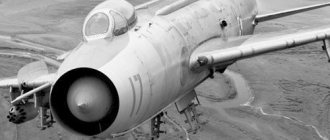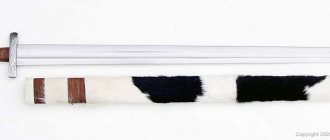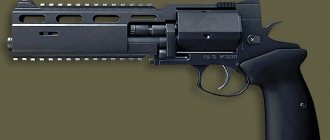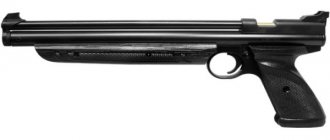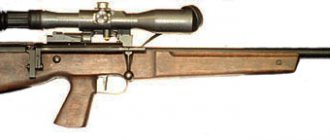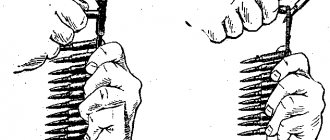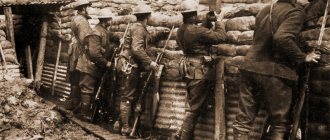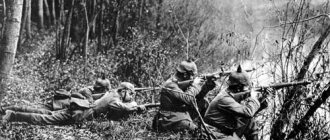German cartridge 7.92 × 57 mm for the Mauser rifle.
The German unitary cartridge
of 7.92 mm caliber with a bottle-shaped case for
the Mauser rifle and machine guns
, 57 mm long with a non-protruding rim, was developed and, having successfully passed all checks and tests, by the very authoritative Prussian weapons testing commission at that time, was unconditionally accepted for service German armed forces back in 1888. This all happened with the simultaneous commissioning of the Gewehr 1888 rifle, which proved to be excellent. Initially, the cartridge had a rounded (blunt-headed) bullet and was officially marked M/88.
A little later, a cartridge with the parameters 8×57 IS was developed (the letter “S” means the German word “Spitz”, which translated into Russian means “pointed”, and accordingly had a sharp bullet and was rightfully the main combat cartridge of the German army, not only in period of battles of World War I, but was used without changes by the Wehrmacht and troops in World War II. Its bullets were used for various purposes and the most popular in the army of Nazi Germany was the cartridge of the same name with a heavy pointed bullet indexed sS (decoding schweres Spitzgeschoss) weighing approximately 15 grams.
This ammunition was intended for firing from absolutely all types of machine guns - easel, manual, aviation, as well as Mauser rifles and carbines, which were in service with absolutely all of the Wehrmacht. For the best shooting, including at air targets with anti-aircraft guns, from machine guns widely used by infantry - MG 34 and MG 42, the designers created a cartridge with a special armor-piercing bullet SmK (full designation Spitzgeschoss mit (Stahl) Kern). It is especially worth noting that at the same time an outwardly identical cartridge with a dangerous explosive bullet (B - beobachtung) was created, initially used as a sighting bullet, but very dangerous and cruel in the consequences for the soldier struck by it. It was banned by the command for use when shooting at personnel on the Western Front, but was used without any restrictions on the Eastern direction.
The 7.92×57 Mauser cartridge of the 1904 model had the following characteristics Caliber - 7.92 Cartridge length, mm - 71.05 - cartridge cases, mm - 51.18 cartridge weight, 20 grams - cartridge cases - about 10 grams - bullets, gr: - armor-piercing - 12 - tracer - 11.5 - from art. core (standard purpose) - 12.8 Initial bullet speed at the muzzle - 735 / 875 meters per second.
There is information that in 1903-1905 the infantry cartridge was modernized by placing in the cartridge case a pointed bullet “S” (Spitzgeschoss) with a slightly larger caliber - 8.22 mm, which was more advanced on the trajectory and additionally increasing the mass of the powder charge to about 3.2 grams and slightly deepening the rifling in the barrels of the weapons on which it was used.
The new shape and chemical composition of the gunpowder, without changing the dimensions of the cartridge case, made it possible to greatly increase the charge, raise the pressure in the barrel bore to 3200 atm., increase the initial speed of the bullet to almost m/s, thereby improving the flatness of fire, accuracy, and penetration effect at almost all distances except the shortest (due to increased deformation of the bullet when meeting the target). Since the changes were not significant, the original index and marking of the cartridge was retained with the addition of “S” (from the word Spitze - pointed) - 7.92 × 57 S or 7.92 × 57 IS.
The sleeve was bottle-shaped and initially brass was used due to its good abturation; later it was replaced by steel, which was clad or varnished to protect against corrosion. The bullet is placed in the cartridge case and secured by crimping the barrel into the annular groove located on the body of the bullet. The capsule is mounted on varnish, which is reinforced with three point cores.
Cartridges for Mausers had a huge number of manufacturers and, therefore, markings. On the bottom of the most common cartridge cases during the Second World War, the stamp S* and the marking corresponding to the manufacturer, batch and date, namely the year of production of the cartridges, were applied.
The cartridges that were produced by enterprises of the Polish and Czechoslovak sector of the German weapons group had four vertical marks on the bottom of the cartridge case, dividing it into equal sectors, and the S* stamp was not applied to them. Some Polish-made cartridges had a Nazi eagle stamped on the base and used a bullet with a cupronickel silver jacket. This ammunition still has an excellent appearance and is an excellent example for all interested people to familiarize themselves with this ammunition.
Rifle design
Generally speaking, the Mauser K98 rifle is a repeating weapon with a rotating bolt. The stock was made of walnut or durable beech, its neck was made in the shape of a pistol grip. The receiver was fastened with two screws - from the stop and from the tail. There is a counter-screw to prevent spontaneous unscrewing of the stops. The forend was attached to the receiver with two metal rings. The bayonet was attached to a special tip under the barrel.
Shop and food features
The rifle has a non-detachable box magazine for 5 rounds, which is completely recessed into the stock. The cartridges in the store are placed in a checkerboard pattern. When equipped, they are inserted through the top window (with the shutter open) one at a time or using a special clip. For this purpose, grooves are provided on the back of the window. Early modifications required manual removal of the empty clip, while in later modifications it was ejected itself when the bolt was closed. The bottom magazine cover was removable, specifically to facilitate cleaning and inspection. It is impossible to load a cartridge directly into the chamber; this may lead to breakage of the extractor tooth.
Sniper option
Of course, by massively developing snipering, the German government could not help but take care of proper weapons for future shooters. Similar initiatives were practiced at the beginning of the First World War. Already at the end of it, the Germans had at least 6 sniper rifles per standard company, while in Russia these did not yet exist. It was the sniper troops that played a key role during the “positional” war during the First World War. The Entente forces suffered heavy losses without even attacking the enemy.
In 1923, Germany became interested in the new carbine - 98K, ordering the production of sniper samples with an optical sight. Each company received 12 such rifles.
After the attack on the USSR, the blitzkrieg worked (for a while), and they forgot about snipers. Until 1942, when the USSR began to use them in defense, the Germans immediately remembered marksmanship and began mass training of sniper soldiers.
The Mauser 98K sniper rifle began to be supplied en masse to the troops only after the attack on the USSR. In 1942, the percentage of rifles with an optic mount was approximately 6% of the total number. But as the war progressed, this figure dropped to 2%. However, an analysis carried out after the war showed that German sniper rifles were significantly inferior to their Soviet counterparts.
To transform the carbine into a sniper model, it was equipped with a mount for the Zf 41 sight, with a magnification of 1.5 times. Such a sight did not allow for long-range shooting, so mostly Soviet trophies or other weapons more suitable for this role were used. In addition, more advanced models of sniper weapons appeared.
Operating principle of the pistol mechanism
When a weapon uses automatic weapons that operate on the principle of barrel recoil, the locking occurs behind the support pads located on the bolt.
After the shot is fired, the barrel, which is movable, travels a short distance while locked. After this, the under-barrel cylinder rests against the ledge of the pistol frame, turns perpendicular to the axis of the barrel and unlocks it, thereby allowing the bolt to move away.
The cylinder in the pistol mechanism is connected to a movable box, in front of which the barrel of the weapon is screwed in, and in the inner part the rectangular bolt moves. The larva engages the bolt with two cut teeth on the upper plane. When the mechanism begins to move back, the cylinder lowers, the bolt is released and the barrel stops. In this case, the bolt throws up the spent cartridge case, the open hammer is cocked and a new cartridge is sent into the barrel.
Modernity
Nowadays the Mauser K-98 rifle is found mainly as a hunting weapon. This is facilitated by the power of the cartridge and good qualities, allowing you to shoot even a large animal.
Another area where the Mauser 98K is used is reconstruction. Since it was the main weapon of the Wehrmacht, it is the Mauser that is used in recreating the battles of that time (for those who chose the German side, of course), along with the MP-40 and the Luger pistol.
The influence of the Mauser design on modern weapons is clearly visible to this day. Most of the successful sniper rifles of our time are produced according to it (original or modified). The materials and technologies available now allow for greater range and accuracy in combat, and the Mauser design is good for just this. Therefore, it is not surprising that it is still relevant today. In addition, replicas are produced for sport shooting, as well as non-combat versions (for collecting).
Results
What can we say by summing up the available information? Undoubtedly, the developer of the Mauser rifle managed to create a practical and reliable weapon that was in many ways ahead of its time. Its high combat qualities and performance characteristics made it popular for almost half a century. And some of its variants and modifications are still used in our time. So the German Mauser rifle can easily stand on a par with such legendary weapons as the Maxim machine gun, Kalashnikov assault rifle, M16 and Mosin rifle.
Prevalence of Mauser
This model had considerable popularity as a civilian weapon almost until the fortieth year of the twentieth century. Explorers, hunters, bandits, travelers - all those who needed a compact and also powerful weapon, each widely used the Mauser for their own purposes.
At the same time, the Mauser S-96 pistol could not receive such widespread official use in the regular military forces of any power, but some countries purchased and used this type of weapon in relatively small quantities for certain categories of military.
Also, this type of weapon was quite actively unofficially used in many military conflicts in countries in different parts of the world. The high rate of fire of the automatic model placed the Mauser a notch higher than other similar firearms.
The fact that this brand of pistol was not widely used is explained by the fact that it was expensive, heavy and relatively large. In addition, the Mauser easily and heavily became clogged with dirt, and was difficult to clean due to the complex process of disassembling and assembling the mechanism.
Another reason for the lack of popularity was the design of the safety lock: the weapon placed on it could not be quickly unlocked with one finger in the event of an unexpected threat, which forced the owner of this weapon to take risks.
